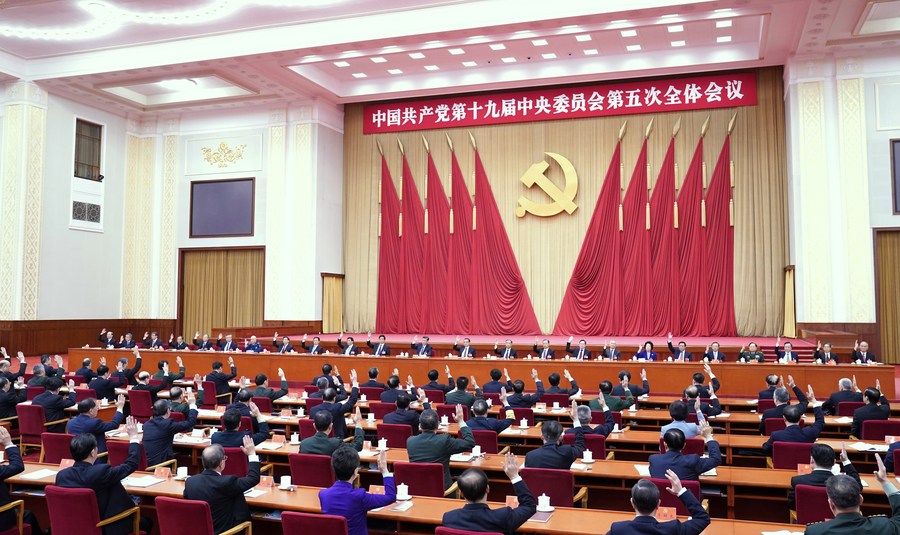Blueprint attracts extensive, positive responses


The Fifth Plenary Session of the 19th Communist Party of China Central Committee, which concluded on Thursday in Beijing and laid out a blueprint for the country's future, has attracted extensive and positive media coverage.
The plenum agreed that China would not allow external pressures to sway it from its course of development. This defines a consensus view of China's progress toward its destiny of a great revival, the South China Morning Post's editorial said.
"It has already grown its economy and power and influence to a critical size. If it remains focused on keeping its house in order in the face of external pressures and 'black swan' events, then its continued rise is seen as inevitable," according to the newspaper in Hong Kong.
The plenum, which set out plans for not just the next five years but the next 15, has sent a clear signal that in the next five to 10 years the country is going to double down on technology and science, according to the editorial.
"While stressing the importance of maintaining focus, the vision reflects the view that given China's momentum and the changing international environment, it has reached the stage where it no longer has to rely on outside markets for capital," it said.
Malaysia's electrical and electronics sector stands to benefit from China's 14th Five-Year Plan (2021-25), where the world's second-largest economy is expected to emphasize technological innovation, according to Malaysian newspaper The Star.
The focus of the five-year plan could potentially benefit Malaysia, given that electrical and electronics exports to China formed a large proportion of Malaysia's exports, The Star quoted RHB Investment Bank Bhd ASEAN economics research head Peck Boon Soon as saying. China is likely to lead global growth in this new cycle, Peck said.
Malaysia's exports to China have now risen substantially to 15.5 percent from only 3 percent about 20 years ago, making China the largest export destination for Malaysia, according to Peck.
MIDF Amanah Investment Bank Bhd Research economist Mazlina Abdul Rahman said that China is likely to accelerate measures at least to ensure future technological prowess, which will continue to increase its demand for semiconductors, according to The Star.
China, Mazlina said, has now emerged as the world's largest semiconductor importer, with its spending on the segment growing by more than double over the past decade.
"This is expected to continue in the near future as the economy is still heavily reliant on imports for the materials, which could possibly benefit Malaysia's semiconductor industry," she said.
The communique of the plenum, which was published on Thursday, implied a path of economic expansion without mentioning the pace of gross domestic product growth explicitly. The previous five-year plan in 2015 had outlined a goal for medium-to-high growth, according to Bloomberg.
The communique said that "China's GDP per capita should match the level in moderately developed countries by 2035", economists at Australia and New Zealand Banking Group, led by Raymond Yeung, wrote in a note.
"Although no specific figures or names were mentioned, a reasonable expectation is that China will aim to reach GDP per capita levels similar to that of South Korea, Israel, or Spain over the next 15 years. The GDP per capita of these countries are $35,000-40,000 in today's prices, compared with China's $10,261 in 2019."
Financial services company UBS Group AG said the focus on technology and innovation will accelerate an industrial upgrading.
UBS economists Wang Tao and Ning Zhang wrote in a note, "We think China may target a higher spending in R&D (possibly 3 percent of GDP by 2025) and education in the new five-year plan", according to Bloomberg.
The economists added that in light of tech restrictions, China may allocate more resources to fundamental and frontier research, and technology bottleneck areas.
China pledged to continue opening up its economy and to take it to a "higher level".
"The fifth Plenum called for international collaboration through high-level opening up," Barclays Plc economists led by Chang Jian in Hong Kong wrote in a note.
- China-Russia joint patrol reflects mutual resolve on regional security
- Rednote ban undermines freedom, harms interests of Taiwan people: mainland spokesman
- Shantou fire death toll rises to 12
- Former Chinese official Qizhala being prosecuted for bribery
- China launches Lijian 1 rocket, sending 9 satellites into orbit
- 'Trend' voted word of 2025 across Taiwan Strait




































